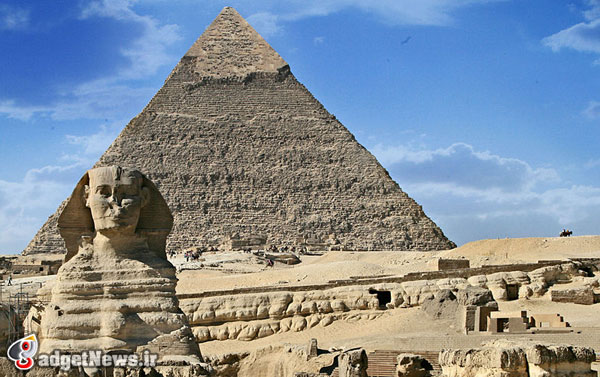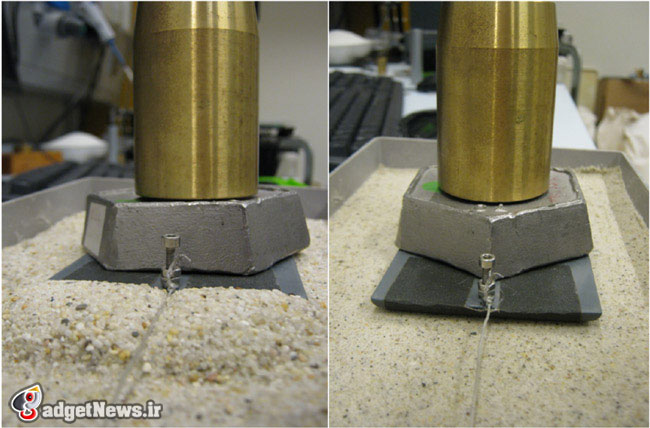
اهرام ثلاثهی مصر یکی از عجایب هفتگانهی جهان است که علیرغم گذشت سالها از زمان ساخت آن، هنوز سوالات بیجواب بیشماری در مورد آن باقی مانده است. یکی از مسائل مطرح شده نحوهی انتقال مصالح، مخصوصاً سنگهای غولپیکری است که در ساخت این سازهها به کار برده شده است. براساس آخرین یافتهها به نظر میرسد مصریها در انتقال این سنگها از آب نیز بهره گرفتهاند.
شاید ساخت سازههایی چون اهرام ثلاثه با دستاوردهای کنونی بشر و علم مهندسی ساختمان چندان سخت نباشد، اما ساخت این سازهها در اعصار گذشته، مطمئناً بسیار سخت بوده است، چرا که حجم سنگهای استفاده شده در این ساختمانها بسیار بزرگ است که منجر به سنگین شدن آن میشود. یکی از اساتید دانشگاه آمستردام و محقق بنیاد پژوهشهای مواد اعتقاد دارد که مطمئناً در آینده و با انجام تحقیقات بیشتر جوابی منطقی برای انتقال این سنگها و نحوهی ساخت این سازهها یافته خواهد شد.
اولین مرحله از معادلهی قدیمی در مورد انتقال سنگها و مجسمههای ساخته شده توسط سورتمههایی است که در بسیاری از منابع تاریخی به آن اشاره شده است. مطمئناً تا حال تجربهی پیادهروی روی ماسه را داشتهاید. یکی از نکات جالب توجه در مورد ماسه، سهولت راهرفتن روی ماسههای خیس در مقایسه با ماسههایی است که خشک هستند. بطوریکه فرد برای راهرفتن روی ماسههای خیس نیاز به مصرف انرژی کمتری دارد. براساس نظر فیزیکدانها وجود رطوبت به میزان مناسب در ماسهها منجر به کاهش انرژی مورد نیاز برای کشیدن سورتمه به نصف میشود.

برای آزمایش این نظریه، دانشمندان یک نمونهی آزمایشگاهی از محیط مورد نظر را شبیهسازی نمودند، بطوریکه سورتمه با داشتن یک بار سنگین برای نمونه و همچنین میزان معتنابهی ماسه، شرایط محیطی مشابه را پیادهسازی کرده بود. دانشمندان با کشیدن این سورتمه فاکتورهای متعددی را که مرتبط با این نظریه است، مورد سنجش قرار دادند که میتوان به نیروی مورد نظر، رطوبت و همچنین سفتی ماسهها اشاره کرد.
براساس گزارش منتشر شده زمانی که ماسه با استفاده از قطرات آب خیس میشود، همچون پلی میان دانههای ماسه عمل کرده و آنها را به یکدیگر میچسباند. در حضور رطوبت به میزان مناسب، ماسه به میزان دوبرابر سفتتر از زمان خشک بودن شده و در نتیجه کشیدن سورتمه با بار سنگین نیز سهلتر میشود.
این نظریه برگرفته از ایدههای خلاقانه و یافتههای جدید داشنمندان نیست. در حقیقت وجود نقاشیهایی در مقبرهی یکی از فراعنهی مصر این ایده را در ذهن دانشمندان متبلور ساخته است. این نقاشی در بردارندهی تصویری است که در آن شماری از کارگران در حال کشیدن یکی از مجسمههای غولپیکر هستند و فردی در جلوی سورتمه در حال ریختن مایعی روی زمین است با یافتههای جدید دانشمندان همخوانی دارد.
منبع : cnet
How did Egyptians move pyramid stones? Mystery may be solved
Alien pyramid-building theories take a blow as a new study shows Egyptians may have used water to help move the massive stones.
Throughout history, people have looked upon the ancient pyramids of Egypt and scratched their heads, wondering how all those giants blocks of stone were moved across the desert and stacked up high. Physicists from the University of Amsterdam and the Foundation for Fundamental Research on Matter believe they have an answer as to how those stones were moved.
The first part of the equation is that stones and statues were placed on sledges and pulled across the sand. If you've ever walked on a beach barefoot, you know it's slowgoing when you're in dry sand, but much easier when you're walking on wet sand. The physicists say the correct amount of dampness in the sand halves the amount of pulling force required to move a sledge with a honking huge stone on it.
To test the idea, the scientists created a lab model of how it would work, using a small version of a sledge pulled across a tray of sand. They measured the amount of pulling force needed to move the sledge as well as the stiffness of the sand.
"Capillary bridges arise when water is added to the sand. These are small water droplets that bind the sand grains together. In the presence of the correct quantity of water, wet desert sand is about twice as stiff as dry sand. A sledge glides far more easily over firm desert sand simply because the sand does not pile up in front of the sledge as it does in the case of dry sand," the report reads.
The results were published this week in the journal Physical Review Letters with the title "Sliding Friction on Wet and Dry Sand."
This theory isn't just a case of scientists coming up with creative solutions long after the fact. A wall painting found in the tomb of ancient Egyptian ruler Djehutihotep depicts Egyptians pulling a sledge laden with a massive statue on board. One of the people in the painting leans over the front of the sledge, pouring what appears to be water onto the ground ahead.
Of the many theories related to the movement of large stones and statues in ancient Egypt, this approach appears to be a pretty solid one. It probably won't dissuade enthusiastic alien theorists from their beliefs, though.
 گجت نیوز آخرین اخبار تکنولوژی، علم و خودرو
گجت نیوز آخرین اخبار تکنولوژی، علم و خودرو 





